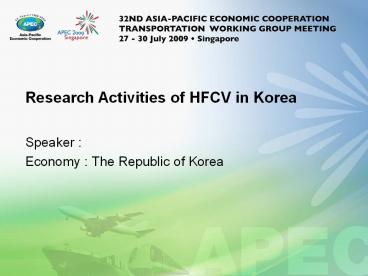Research Activities of HFCV in Korea PowerPoint PPT Presentation
1 / 13
Title: Research Activities of HFCV in Korea
1
Research Activities of HFCV in Korea
- Speaker
- Economy The Republic of Korea
2
Research Activities of HFCV in Korea
27 29, July, 2009
Ministry of Land, Transport and Maritime Affairs,
Korea Transportation Safety Authority (Korea
Automobile Testing and Research Institute)
3
Contents
Hydrogen ?
- Hydrogen Leakage Test
- Driving Mode
- Stop Mode
- Rear Impact Test
- Possibility of Hydrogen Discharge
- Storage Verification Test
- Summaries
Hydrogen ?
4
Hydrogen Leakage Test Driving Mode
- Goal Verification of single failure conditions
- Conditions
- Driving speed 36 km/h
- Open space 14.1 m x 12 m x 6 m
- Leaking point fitting area of high pressure
fuel line and refilling line in the rear of a
vehicle - Leaking flow 131 NL per minute
- Simulation Model
- Tool STAR-CCM
- Mesh polyhedral mesh (1,060,000)
- Turbulence model ?-e model
- Steady-state analysis
5
Driving Mode Simulation Results
- Results
- In hydrogen leaking area, hydrogen concentration
level exceed 4 by volume in air - Hydrogen was diffused by outside air flow
Vehicle underbody view
Section A-A
Detail of B
Air flow outside vehicle
Velocity profile near storages area
6
Stop Mode Test Conditions (1)
- Positions of hydrogen sensor
Positions of sensors (under flower)
- Expected hydrogen leaking points
- High(5)/low(4) pressure lines and engine room(2)
7
Stop Mode Test Conditions (2)
Valve
Valve
Regulator
Storage(35MPa)
leakage
Valve
Valve
Regulator
Storage
Hydrogen leakage device
Single failure conditions test
- Conditions of hydrogen leaking flow
- 10 NL per minute low leaking mode
- 40 NL per minute max. leaking mode before
activation of excess flow valve - 131 NL per minute leaking limit in FMVSS 301
8
Hydrogen Leakage Test Results
- Driving Mode
- Diffused rapidly due to wind flowing outside
vehicle - Sensors did not detect leaking hydrogen except
sensors near leaking area - Stop Mode
- Leaking hydrogen may enter into vehicle through
holes on the bottom if hydrogen - leaks underneath the body
- Leaking hydrogen may enter into vehicle through
running HFCV system if hydrogen - leaks in engine room ? preventive measure
needed - Hydrogen continued to leak for about 10 seconds
before shutdown - after 2 hydrogen was detected
- ? There were some area where Hydrogen up to 4
was detected before shutdown. - But concentration dropped below 4 within
one minute - Conclusions
- Optimization of number of sensors and their
locations is needed for effective detection - depending on vehicle structure
- ? 2-3 sensors out of 5 sensors may be removed in
case of Tucson HFCV - Interior sensors should be considered for
detecting hydrogen entering from
9
Rear Impact Test (Fuel System Integrity)
- Goal Verification of fuel system integrity
- Test Conditions
- KMVSS article 91(FMVSS 305) 48 km/h rear
impact test - Filled with helium 90 of normal working
pressure - During the crash, opened storage valve (severe
condition) - After crash test, evaluate hydrogen discharge
- Test Vehicle
- Mock up fuel cell vehicle
BIW of HFCV
SUV (Tucson)
Mounted storages
Sample vehicle
10
Rear Impact Test Results Hydrogen Discharge
- After impact, no hydrogen discharge
- High pressure sensor 30 MPa
- Low pressure sensor 10 MPa
11
Rear Impact Test Results Verification Test of
Storage
- Verification Test of Storage
- Storage was damaged due to deformation of
suspension during impact - Verification test of damaged storage ? No
noticeable degradation
Damaged carbon fiber layers of storage
Under body rear suspension
Verification test of damaged storage ? Passed
after 11,250 cycling tests at 103 MPa
12
Summaries
- Hydrogen Leakage Test (Single Failure Conditions)
- Optimization of number of sensors and their
locations is needed for effective detection - depending on vehicle structure
- 2-3 sensors out of 5 sensors may be removed in
case of Tucson HFCV SUV - Interior sensors should be considered for
detecting hydrogen entering from outside - Rear Impact Test (Fuel System Integrity)
- Exterior of storage was damaged due to
deformation of suspension during Impact - ? No noticeable strength degradation after
endurance test - No malfunction in other storage components
- Impact absorbing structure should be devised
13
Thank you for your attention !

